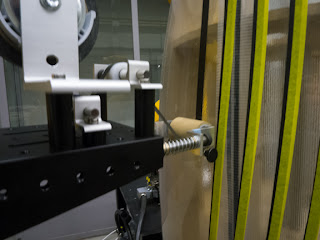chainsaw robot carves the 7Xstool by tom pawlofsky + tibor weissmahr
http://www.designboom.com/design/7xstool-by-tom-pawlofsky-tibor-weissmahr/
berlin-based company echtwald has entered a new partnership with kkaarrlls - a platform for a collection of objects resulting from coursework realized by young european designers at karlsruhe university of arts and design - with a series of pieces presented during passagen 2013/interior design week in cologne. as a highlight of kkaarrlls exhibition was a public performance shown twice a day, where the stackable 7Xstool was cut straight from a tree trunk by an industrial robot with a chainsaw. the unusual production process was developed by german designer tom pawlofsky with the form of the seating conceived together with fellow creator tibor weissmahr. the machine carved the stools with millimeter precision, and through careful planning of the saw’s tracks, the technique offered nearly scrap-free results. the pieces were then able to be purchased by audience members following the impressive presentation.
1/24/2013
1/15/2013
inflatable robots
Why are robots rigid and hard? Otherlab founder and MacArthur Genius Grant recipient Saul Griffith explains why he invented inflatable robots. The RAV4 EV Charge-to-Charge Tour visits Griffith’s Otherlab.
1/10/2013
1/09/2013
PINOKIO
https://vimeo.com/53476316
with Processing, Arduino, and OpenCV.
Pinokio is an exploration into the expressive and behavioural potentials of robotic computing. Customized computer code and electronic circuit design imbues Lamp with the ability to be aware of its environment, especially people, and to expresses a dynamic range of behaviour. As it negotiates its world, we the human audience can see that Lamp shares many traits possessed by animals, generating a range of emotional sympathies. In the end we may ask: Is Pinokio only a lamp? – a useful machine? Perhaps we should put the book aside and meet a new friend.
with Processing, Arduino, and OpenCV.
Pinokio is an exploration into the expressive and behavioural potentials of robotic computing. Customized computer code and electronic circuit design imbues Lamp with the ability to be aware of its environment, especially people, and to expresses a dynamic range of behaviour. As it negotiates its world, we the human audience can see that Lamp shares many traits possessed by animals, generating a range of emotional sympathies. In the end we may ask: Is Pinokio only a lamp? – a useful machine? Perhaps we should put the book aside and meet a new friend.
1/06/2013
Rob|Arch 2012
simulating a composites manufacturing process called
automated tape lay-up (ATL) using three robotic arms
using maya kinematics, python scripting and VAL3
to control three staubli arms in synchronization
custom tape head assembly attached to an arm lays
gaffers tape along a rotating mandrel
gaffers tape along a rotating mandrel
1/03/2013
Flying Robots Build a 6-Meter Tower
http://www.zeitnews.org/node/3210
This is the Flight Assembled Architecture, an installation near Paris January 2012. It's the result of a collaboration between ETH Zurich roboticist Raffaello D'Andrea and architects Fabio Gramazio and Matthias Kohler, also from ETH. D'Andrea, an IEEE Fellow and IEEE Spectrum editorial board member, is known for his amazing robotic sculptures and flying robot stunts, and Gramazio and Kohler, who run their own design studio, are pioneers in bringing together robotics and architecture. But for an installation at the FRAC Centre, in Orléans, near Paris, they wanted to do something entirely new and bold. Using a fleet of quadcopters they built a 6 meter (20 feet) twisting tower out of 1500 foam bricks.
This is the Flight Assembled Architecture, an installation near Paris January 2012. It's the result of a collaboration between ETH Zurich roboticist Raffaello D'Andrea and architects Fabio Gramazio and Matthias Kohler, also from ETH. D'Andrea, an IEEE Fellow and IEEE Spectrum editorial board member, is known for his amazing robotic sculptures and flying robot stunts, and Gramazio and Kohler, who run their own design studio, are pioneers in bringing together robotics and architecture. But for an installation at the FRAC Centre, in Orléans, near Paris, they wanted to do something entirely new and bold. Using a fleet of quadcopters they built a 6 meter (20 feet) twisting tower out of 1500 foam bricks.
Subscribe to:
Posts (Atom)






